Types of Dental Burs in Dentistry
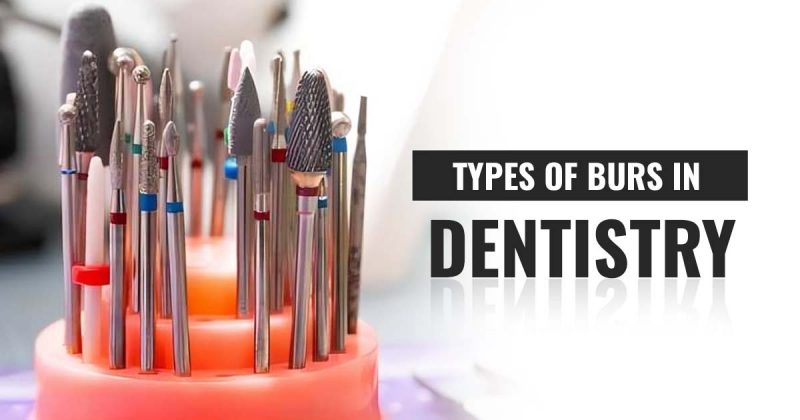
Types of Burs in Dentistry – Are you aware that even small tools can create great changes within the sector? Take dental burs for instance. Although they are small in size, these dental instruments play a significant role in different oral procedures. Whether it is about preparing minute cavities or doing complex bridgeworks, dental burs remains crucial in enhancing accuracy along with quality of dental services delivery to patients. This exemplifies that dentistry is a keen game where even minute details can determine how a patient may be affected after being treated. In this article we will discuss various types of dental burs and their uses within the field of dentistry.
What is a dental bur?
A dental bur is a rotary cutting instrument that has a bladed head and is utilized for numerous purposes. It possesses a tiny, sharp-edged head which rotates so as to cut, abrade or shape dental tissues as well as other related materials. These come in different shapes, sizes, and materials to suit specific dental needs and ensure precision during dental treatments.
Types of Burs in Dentistry
Parts of bur:
Parts of bur include the following :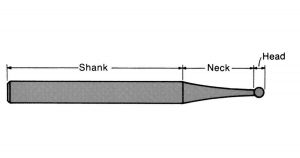
- Shank– It is that part of the bur that fits into the handpiece and accepts the rotary movement of the handpiece. It also controls the concentricity and alignment of the instrument. These are of the following three types:
- Straight handpiece shank (HP type)
- Latch-type handpiece shank ( RA type)
- Friction grip handpiece shank (FG type)
- Neck – It connects the shank to the head and transmits the rotational and translational forces to the head.
- Blade – It is the primary functional part of the bur. It can be used for cutting and abrasion purposes depending on the head characteristics. It is available in different head sizes and shapes.
Classification of Burs :
There are several classification systems for burs:
- Based on their attachment to the handpiece:
- Long straight/ handpiece type
- Latch type
- Friction grip type
- According to their composition:
- Stainless steel burs
- Tungsten carbide burs
- Diamond burs
- Ceramic burs
- According to their motion:
- Right bur: A right bur cuts when it rotates clockwise
- Left bur: A left bur cuts when it rotates counterclockwise
- According to head length:
- Long
- Short
- Regular
- According to their use:
- Cutting burs
- Finishing burs
- Polishing burs
- According to their shapes:
- Round bur
- Inverted cone bur
- Pear-shaped bur
- Wheel shaped bur
- Taper fissure bur
- Straight fissure bur
- End cutting bur
According to the dental bur’s attachment to the handpiece:
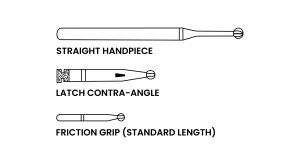
- Straight handpiece shank (HP type )- These are the burs that have a long cylindrical structure that fits into a straight handpiece and are held with a metal chuck.Usually, used in dental laboratories at low speed.
- Latch-type handpiece shank ( RA or CA type) – This handpiece features a flat section on the back of the shank, creating a D-shaped socket where the end of the bur fits. Instead of using a chuck to hold the bur, a latch secures it by engaging with the grooves at the end of the bur’s shank. This type of bur is commonly used in contra-angle handpieces for finishing and polishing tasks at low speeds.
- Friction grip handpiece shank (FG) – This shank is cylindrical in design but significantly smaller compared to the other two types. The bur is secured in the handpiece by the friction between the shank and the metal chuck, allowing it to be used at high speeds for various dental procedures. Friction grip burs are further divided into:
o FGSS (Friction Grip Short Shank) dental burs
o FGOS (Friction Grip Operative Surgical) dental burs
According to dental bur’s composition:
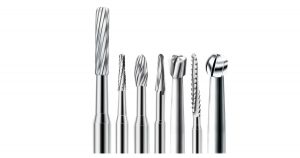
- Stainless steel burs – These burs are made from corrosion-resistant alloys consisting of – iron, chromium, and nickel. They are used for cutting soft carious dentin and trimming, finishing and polishing restorations. Steel burs generally have lower durability compared to other materials, which can make them less suitable for extensive tooth reduction. Additionally, they may not be as efficient at cutting harder materials as carbide burs.
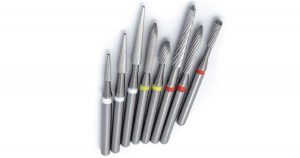
- Tungsten carbide burs – These are made up of tungsten and carbon. The high-speed handpieces have led to the emergence of tungsten carbide burs that are made to resist extreme pressure and last longer. Being known for its command over force, toughness and endurance, they are employed in different dental operations like cavity preparation, extraction of dental decay, tooth restoration preparations as well as modeling and contouring of dental substances. Due to their accuracy in cutting, these instruments are commonly used in procedures involving implants so that they can effectively design the adjacent bone for perfect fit and stability.

- Diamond burs– Coated with industrial-grade diamonds, these have a better cutting efficiency when cutting through hard substances like dentin and enamel. They are commonly employed in procedures that demand precision, such as zirconia crown preparation and veneer installation. Their high accuracy makes them ideal for intricate detailing, shaping, and contouring. These are expensive and thus, undesirable for routine procedures.
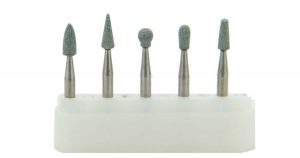
- Ceramic burs- Made up of zirconia, aluminum oxide, and similar ceramic materials. These have a fine abrasive nature and are mostly used for finishing and polishing procedures. When used for soft tissue procedures these provide precision and minimal trauma. Ceramic burs have low heat conduction and thus, are the most suitable choice for cutting bone in an implant surgery. They might be less effective than diamond or carbide burs at cutting through harder materials. Additionally, they can be relatively more costly compared to other types, which can affect their cost-effectiveness.
According to the dental bur’s shape :
There are countless dental burs shapes used in the dental industry, but the following are the main types commonly utilized by dental professionals :
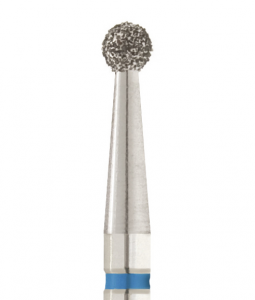
- Round bur – This bur is cylindrical. It is commonly used for making initial entry into the tooth, extending the preparation, creating retention features, and removing caries.
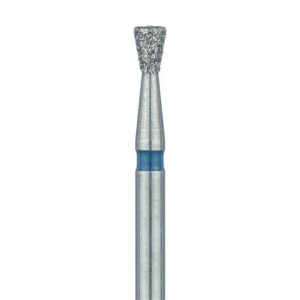
- Inverted cone bur– This bur features a sharply tapered cone with the apex facing the bur shank. The length of the head is roughly equal to its diameter. This shape is especially effective for creating undercuts in tooth preparations.
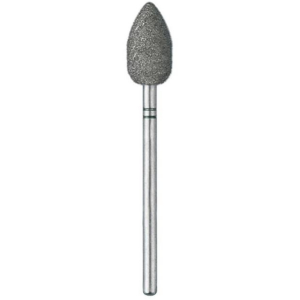
- Pear-shaped bur –This bur features a slightly tapered cone with the narrow end pointing toward the bur shank. The head can be either continuously curved or flat with rounded corners where the sides and flat end meet. It is primarily recommended for tooth preparations designed for amalgam restorations.
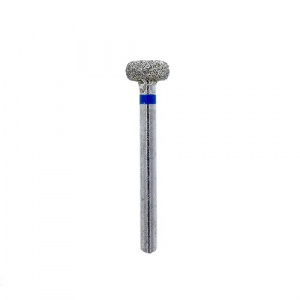
- Wheel shaped bur – These have wheel-shaped bur heads and are available in a variety of diameters. Mostly used in tooth preparations for crowns and veneers and also for precise shaping and polishing.
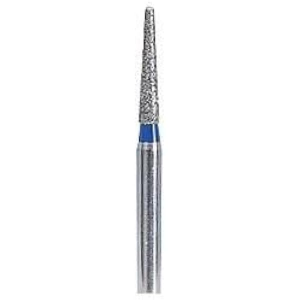
- Taper fissure bur – It has a slightly tapered cone with the small end of the cone directed away from the bur shank. This shape is used in tooth preparations for indirect restorations, where avoiding undercuts is crucial for successfully removing patterns and ensuring the final seating of the restorations. Tapered fissure burs may also be designed with a flat end with the tip corners slightly rounded.
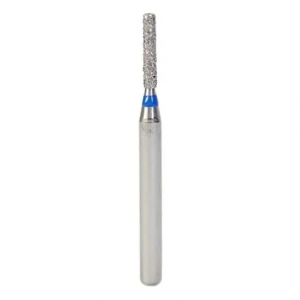
- Straight bur- This bur is an elongated cylinder. Some dentists advocate this shape for amalgam tooth preparation, initial tooth preparations, and straight-line preparations during crown and bridge preparations according to their needs.

- End cutting bur- A very small cutting edge is present in the bur head which helps in precise cutting during tooth preparation procedures. Used majorly during finish line preparations thus reducing the bumps and lips for proper fit of the crown.
At a greater level within dentistry, it is impossible to underestimate the importance of burs. From tiny tools that remain central in many dental operations to major restorations or precise cavity preparations, these tools come in handy. By understanding their different kinds, materials and uses, dentists can have the right tool for every task which will give out good results thus looking after patients’ well-being.
Never before have it been easier for dental practitioners to choose appropriate burs for their practices due to improvement of dental technologies and diversified offers of burs that are available today. For an extensive selection of high-quality dental burs, look no further than Dentalkart.com. As a comprehensive online supplier, Dentalkart has a broad range of burs suitable for all your clinical needs: from cutting, or finishing, polishing to precision work. So, explore our collection and find your perfect burs to ensure success in every dental procedure carried out.

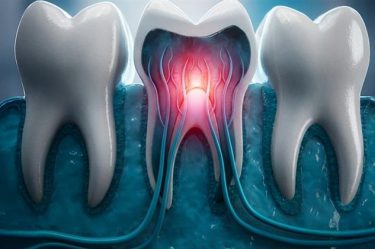
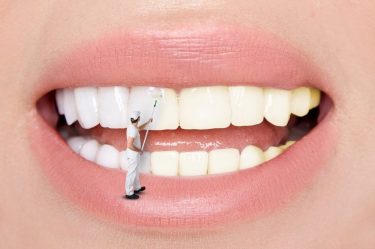

No Comment